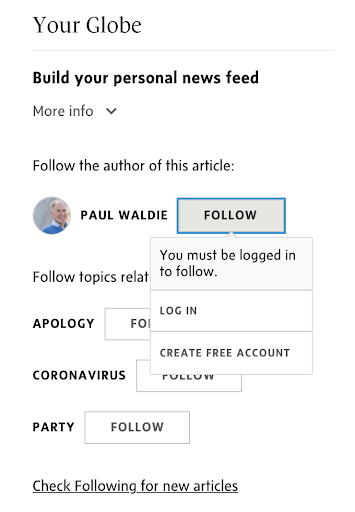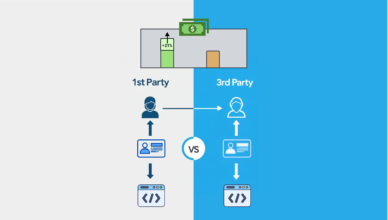It’s no secret that digital models are being turned on their head with the shift to a more privacy-first, cookie-free approach. And, although at first this caused many publishers to worry about how to adapt, the challenge actually represents a major opportunity to become user centric through employing a first-party data strategy.
Not only does this model allow you to collect high quality information about your audience that’s relevant to your business, it also helps establish strong relationships with users, personalize their experiences, understand reader behavior, create value and improve retention rates.
What’s more, by converting users into members in order to collect first-party data, you can increase monetization from other strategies such as subscription or advertising.
After analyzing the average revenue per unit (ARPU) amongst clients, Poool found that registered users are worth 115 times more than a volatile, anonymous user. They’re also much more likely to convert into a subscriber in the future, who will bring the same monthly value as 20 registered users.
So, it’s fair to say that getting to know users and employing a first-party data strategy is hugely valuable to your business! Therefore, the question is: How do you successfully employ this strategy? Here are some of our thoughts:
- Plan which data you want to collect
- Establish a value exchange to collect data
- Progressive profiling
- Become user-first
- Invest in the right tech stack
Plan Which Data You Want to Collect
With so much potential data to collect, it’s important to establish what you actually need in order to achieve your goals. This helps to prevent friction and poor user experiences that involve too much data gathering.
Firstly, identify the questions you want to answer to achieve your goals — which data points will be the most valuable for your advertising clients and strategy?
Next, determine which data types can be paired with your answer to the above.
Finally, establish how you’re going to collect, measure, store and analyze this data. The easiest and most popular option would be to use a data management platform (DMP) or a customer data platform (CDP) depending on your goals and business.
And don’t underestimate the importance of the transfer system between data collection and storage. The connection between each platform and stage is as important as the stages themselves.
Establish a Value Exchange
Users are often more willing to share their data with you if they get something in return. In fact, Google claims that a well established value exchange is the number one way of unlocking the power of your first-party data.
This can be achieved with ease by employing a registration wall that blocks content and asks or requires a user to create a free account in order to gain access. The user gets a better experience through additional content while you’re able to collect first-party data and establish custom reader IDs.
To make this registration value exchange a success, you have to ask yourself whether you’re providing value equal to or greater than the value you’re asking from users.
For instance, you could provide access to exclusive content — similar to The New York Times — allow members to read a premium article for free or sign up to newsletters. Another option is to provide personalized recommendations and allow the user to resume content where they left off, much like Netflix. Alternatively, you could allow account spaces to save content for later, like Channel 4OD, or follow topics and authors, receiving notifications when content is published, which is a model that The Globe and Mail uses.
Poool has created a four-week emailing masterclass for publishers to benchmark, launch and optimize a registration strategy to increase ARPU in the long-term.
Progressive Profiling
The concept of progressive profiling is about collecting user data gradually rather than all at once, a key aspect of your strategy given that it happens before users can see the value you’re providing in exchange. By gathering information gradually over time, and across multiple touch points, you reduce friction and make for a more accessible user experience.
In particular, we’d recommend avoiding long registration forms that can cause users to abandon the account creation process.
Consider simply asking for a name, email address and password to facilitate conversion. You can then start to personalize their experience based on contextual data to learn more about their behavior and interests based on how they interact with your site.
After some time, you’ll be able to develop a 360 view of each member, pairing demographic information from the form with behavioral and psychographic data that is collected over time. You’ll then be able to put this to use in:
- Predicting what they might do next (e.g. predicting churn and taking preventative measures)
- Enhancing personalization to increase engagement
- Improving user experience to boost retention
- Understanding where your audience sees value in your business and focus on these areas
Become User-First
The growing popularity of a first-party data strategy means the start of a new privacy-first era, where publishers understand what their audience want and work closely with users to develop strong, lasting and trusting relationships.
This can be hugely valuable to your business. Making the most of first-party data to become consumer-centric is likely to lead to an increase in both user engagement and associated revenue.
How can you ensure this?
- Collect compliant consent in a way that respects user choice and the relevant regulations in your location.
- Transparency in your strategy: make users aware of what data you collect, how you collect it and why it’s valuable to you.
- Visibility: don’t hide your cookie banners or information about data collection. Make sure it’s visible and clear to users.
The Guardian’s consent banner, for instance, is honest, visible and transparent in how the publisher uses data.
Invest in the Right Tech Stack
Choosing the right tech stack depends on your objectives, but it should allow you to collect data, bring together all your data points and put the information to use to provide insights about your audience.
We’d recommend:
- Consent Management Platform (CMP) depending on where you are in the world, but this is a must for European publishers to collect and store consent from users as well as personalize each aspect of the consent banner design and text.
- Audience Conversion Platform to employ a registration wall for collecting data from your audiences. This platform should allow you to personalize the wall and form fields, segment audiences to provide adapted journeys as well as send data directly to your chosen data management platform.
- Customer Data Platform (CDP) as it focuses on collecting and organizing first-party data from various touch points as well as feeding information to your other tools, helping your conversion, marketing and advertising strategies.
Disclaimer: The views, opinions and ideas expressed in this post belong to the author/s and do not necessarily reflect those held by State of Digital Publishing.











